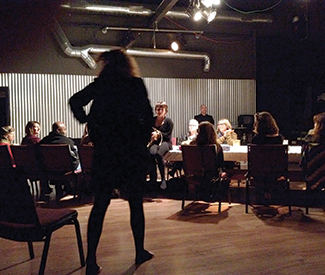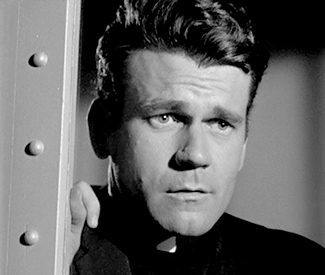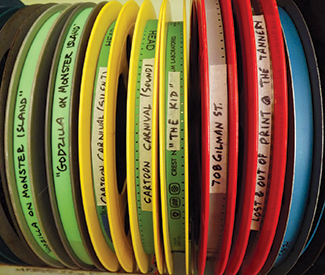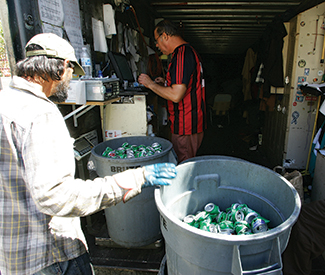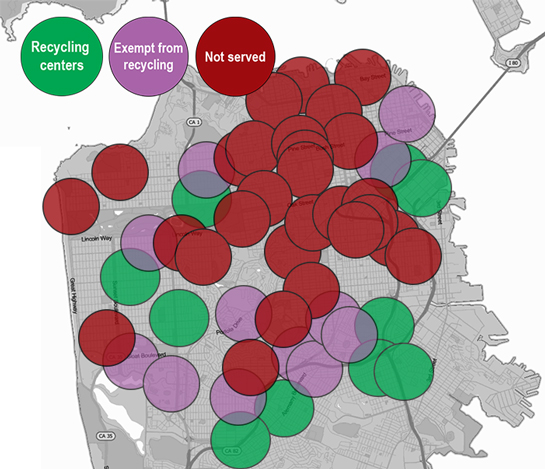San Francisco elected officials frequently celebrate the ambitious citywide goal of sending zero waste to the landfill by 2020, an environmental feat widely viewed as attainable since the current waste diversion rate stands at a stellar 80 percent.
Official city numbers — based on reporting by Recology, a company that has a monopoly on trash collection and curbside recycling in San Francisco — demonstrate that only 20 percent of all city dwellers’ trash ends up in a landfill, that unenlightened dead end for matter discarded from our lives, never to be reprocessed.
Yet a lawsuit against Recology exposed some inconsistencies in the company’s record keeping. It also shed light on how some material counted as “diverted” is routinely sent to a landfill anyway, a practice that muddies the concept of the city’s Zero Waste program but is nevertheless legal under state law.
On June 17, a San Francisco jury determined that Recology misrepresented the amount of waste diverted from the landfill in 2008, enabling it to collect an incentive payment of $1.36 million for meeting the goal. The verdict compels Recology to pay the money back to the city, since it was obtained after submitting a false claim.
The outcome of this lawsuit — brought by a former manager of the Tunnel Road recycling Buy Back facility, who also claims he was retaliated against for trying to expose fraud — highlights some larger questions. Was this inaccuracy unique to 2008, or are Recology’s numbers always a little fuzzy? Are there adequate safeguards in place to prevent the company from fudging the numbers, particularly when both company and city officials have an incentive to exaggerate the diversion rate? And if what’s on paper doesn’t quite square with reality, is San Francisco really keeping as much garbage out of the landfill as the city’s Department of the Environment says it is?
Attorney David Anton, who represented the former Recology employee, Brian McVeigh, said he found it odd that San Francisco officials didn’t show much interest in collaborating to recover the bonus money, even though millions of dollars was potentially at stake. Since damages are trebled under the False Claims Act, cited in the lawsuit, Recology could ultimately be made to fork over the incentive payment three times over.
“The city’s representative in the Department of the Environment actually testified that he hoped this lawsuit would be unsuccessful,” Anton recounted. He guessed that officials remained on the sidelines because in San Francisco’s political power centers, “relationships with Recology are so close and tight. It was a very strange thing,” he went on, “to be pursuing this lawsuit, trying to get money to the city, and the city’s representatives are saying, ‘we don’t want it.'”
Recology has filed post-trial motions in a bid to have the penalty reduced, “asking the court to decide whether there was any evidence at trial that there were public funds in the Diversion Incentive Account, and if so, how much,” explained Recology spokesperson Eric Potashner. “We expect a ruling this summer.”
Department of the Environment spokesperson Guillermo Rodriguez told the Guardian that Robert Haley, manager of the department’s Zero Waste team, was unavailable for comment before press time. With regard to the lawsuit, Rodriguez noted, “The city has been following the trial closely and is awaiting the judge’s ruling on post-trial motions before determining any reaction.”
FALSE CLAIMS
The False Claims Act is designed to recover damages to government when false statements are made to obtain money or avoid making payments. It has a provision allowing whistleblowers, such as McVeigh, to lead the charge on seeking civil enforcement action. The whistleblower may be eligible to receive a share of recovery.
Under the bonus incentive program, Recology sets aside extra cash — collected from garbage customers’ payments — in a segregated account. But it cannot withdraw funds from that account unless it hits the city’s established waste-reduction targets. Recology submitted paperwork to the city in 2008 showing that it met the diversion goals, so it was allowed to withdraw the money.
But the lawsuit demonstrated that Recology actually fell short of those goals — and apparently, nobody in city government ever followed up to check whether the reporting was accurate.
A key reason the jury ruled against Recology on this particular claim, according to Anton, was that it was found to have misclassified some construction and demolition waste as “diverted” material. Under state law, when ground-up construction debris is used to cover the top of a landfill — to prevent pests, fires, and odors, for example — it’s counted as “alternative daily cover.” Trash in this category winds up in a landfill, just like any other trash. But state law allows garbage companies to count it as “diverted,” just as if it were an aluminum can tossed into the blue bin.
The lawsuit claimed that Recology tried to count a great many tons of construction and demolition waste as “alternative daily cover” when in reality, it should have been counted as just plain trash.
Solano County records show that a landfill inspector had flagged an “area of concern” after discovering solid waste mixed in with construction debris Recology shipped to a landfill for use as that top layer. “It looks like they didn’t do a good enough job of cleaning out that material,” CalRecycle spokesperson Mark Oldfield noted as he pulled up the report from 2008 at the Guardian’s request.
Had the material gone to the landfill as just plain garbage, instead of “alternative daily cover,” Recology would have had to count it as waste sent to the landfill, instead of waste diverted from the landfill. That would have meant falling short of the waste diversion goal, hence losing out on the $1.36 million.
“Recology kept this completely secret from San Francisco,” according to Anton.
Potashner said it was actually a bit more complicated — the company challenged the inspector’s findings, he said. “The local enforcement agency in Solano County had questions about that material,” but Recology never received a cease-and-desist order, he added. “When we had talked to jurors after the fact, that was the issue that seemed to sway them. In 2008 we didn’t make that bonus by that much. They thought we shouldn’t have been able to count that as diversion because of this issue.”
Either way, the incident exposes a strange reality: When San Francisco city officials trumpet the citywide success of “diverting” 80 percent of all waste from the landfill, some portion of that 80 percent actually winds up in a landfill anyhow. Whether the construction debris counted as “alternative daily cover” has trash mixed into it or not, it’s still destined to wind up in a big, environmentally unfriendly trash heap.
CONCRETE NUMBERS
The lawsuit highlighted a few other red flags, too, raising more questions about the city’s true diversion numbers. For instance, the suit claimed that Recology was involved in a system of digging up concrete from its own parking lots, to be handed over to concrete recyclers as “diverted” waste.
“Recology facilities have large areas of concrete pads,” the complaint noted. “Management of Recology … directed Recology work crews in 2005, 2006, 2007, and 2008 to cut out sections of concrete pads and deliver the removed concrete to concrete recyclers, to falsely inflate the diversion incentive reported to SF.”
The waste management company then “solicited cement companies to deliver and dispose of excess and rejected concrete loads to Recology, to fill in the removed concrete pad sections,” according to the complaint. Those shipments were brought in on trucks that weren’t weighed at entry, and then placed in the concrete pads. Management then had work crews remove the same concrete that had been delivered, shipped it to the concrete recyclers, and reported it “as diverted from being disposed in a landfill,” the complaint noted.
This account was corroborated by a Guardian source unrelated the lawsuit, but nonetheless familiar with the inner workings of the company. “They would take the concrete across the road — right across the street,” this person confirmed.
Asked to provide an explanation for this, Recology’s Potashner said, “it is clear, and wasn’t even challenged by the plaintiff at trial, that recycled concrete is diverted, whether it had been from Recology’s lots or anywhere else.”
McVeigh’s case stemmed from his realization, while working as a manager at Recology’s Tunnel Road recycling buyback facility, that employees there were routinely marking up the weights of recyclable materials brought in, in order to pay out certain customers more than they were actually owed. The suit suggests that these routinely inflated California redemption value (CRV) tags contributed to Recology missing its waste-diversion targets, but the jury ultimately sided against the plaintiff on this question since it amounted to a financial loss for Recology, not the city.
The complaint included tag numbers and logs of scale weights that didn’t match up, showing a pattern of fraudulent dealings at the buyback center. In November 2007, for example, “ticket reports showed that 23.4 tons of aluminum CRV cans were purchased at the Bayshore Buyback Center, yet only 16.56 tons existed and were shipped.”
Asked about these claims, Potashner acknowledged that there may have been some “knuckleheads” involved in messing with the scales at the buyback center, but asserted that such activity had since been addressed. He added, “If there were any staffing issues around theft, that was actually affecting Recology’s books,” not the public.
Oldfield, the CalRecycle spokesperson, noted that a long list of paperwork violations had been recorded in 2010, but he said the company appeared to have been in compliance since then — based on logs from inspectors’ visits once a year.
Another problem uncovered in the trial, Anton said, had to do with Recology misrepresenting tons of garbage from out of county, so that it would be counted outside the parameters of the waste diversion program. Potashner said that had been corrected, adding, “the out-of-county waste is really a small volume.”
But he confirmed that yet another practice brought to light in this lawsuit is ongoing, revealing a surprising end for some of the stuff that gets tossed into the green compost bins.
MANY SHADES OF GREEN
According to every colorful flier sent out by Recology, the stuff that goes into the green bin gets composted. The green bin is for compost. The blue bin is for recycling. The black bin is for trash that goes to the landfill. This is the fundamental basis of Recology’s waste collection operation and, taking the company and the Department of the Environment at face value, one would assume that 80 percent of all waste was being processed through the blue and green waste streams.
Instead, some of what gets tossed into green bins makes its way to a landfill.
The green-bin waste is shipped to a Recology facility where it’s turned into compost, a process that involves sifting through giant screens. But some of what gets processed, known as “overs” because it isn’t fine enough to drop through the screens, is routinely transferred to a nearby landfill, where it’s spread atop the trash pile. Once again, this six-inch topper of neutralizing material is known as “alternative daily cover.”
Although Recology could convert 100 percent of its green-bin waste into soil-nourishing compost, the practice of using partially processed green-bin waste for “alternative daily cover” is cheap — and it’s perfectly legal under California law. Roughly 10 percent of what gets tossed into the compost bins is used in this way, Recology confirmed.
“There are some people who will say using green waste isn’t really diversion,” acknowledged Jeff Danzinger, a spokesperson with CalRecycle, which oversees recycling programs in California counties. “There’s some people who say we should stop that practice because that just incentivizes a landfill solution for green waste. But if somebody’s saying green waste shouldn’t go into a landfill and get counted as diversion, it’s an opinion.”
Nor is it something the city objects to. The Department of the Environment is aware of this practice, Recology’s Potashner told the Bay Guardian. Yet the city agency has never raised formal concerns about it, despite a mandate under its composting program agreement that the company use green-bin waste for the highest and best possible use.
But there’s no incentive for anyone in city government to complain: Recology may legally count this discarded material as “diverted” in official reporting, thus edging it closer to an annual bonus payment. San Francisco, meanwhile, may count it as part of the 80 percent that was successfully diverted — thus edging it closer to the ambitious Zero Waste program goal.
“It’s great PR to say you’re the highest recycling,” noted the person who was familiar with the company, but wasn’t part of the lawsuit. “It’s almost a movement more than reality. But who’s really watching for the public on these numbers? There’s no watchdog. It’s all about bragging rights.”
Recology is “a political business”
Recology’s political connections in San Francisco run deep. Years ago, when former San Francisco Mayor Willie Brown served as speaker of the California Assembly, he also worked as a lawyer for Recology, which was then known as Norcal Waste Systems.
Campaign finance archives show that when Brown ran for mayor in 1995, he received multiple campaign contributions from Norcal employees in what appeared to be a coordinated fashion.
Brown continues to be influential in the city’s political landscape due to his close relationship with Mayor Ed Lee, who himself came under scrutiny in his capacity as head of the Department of Public Works in 1999 when he was accused of granting Norcal a major rate increase as a reward for political donations to Brown.
In 2010, when Recology submitted a bid for a lucrative waste-disposal contract proposing to haul waste to its Yuba County landfill, Lee reviewed its proposal in his then-capacity as city administrator. As the Guardian reported (see “Trash talk,” 3/30/10), Lee recommended far higher scores for Recology than his counterparts on the contract review team, a key to the company winning the landfill contract over competitor Waste Management Inc. Before Lee declared his mayoral candidacy in 2011, news reports indicated that powerful Chinatown consultant Rose Pak had worked in tandem with Recology executives on a campaign effort, “Run Ed Run,” organized to urge Lee to launch a mayoral bid. Company employees had also been instructed to help gather signatures to petition Lee to run for mayor, news reports indicated, but Pak publicly denied her role coordinating this effort. David Anton, the attorney for Brian McVeigh, emphasized that Recology’s close ties to powerful city officials might have something to do with the city’s lack of interest in targeting the company for the improperly received incentive payments. Yet Recology spokesperson Eric Potashner called this assertion “completely untrue. Recology meets with the various city departments and regulators weekly. We are constantly improving our controls and practices for handling the city’s ever-changing waste stream; often at the behest of city regulators.” Recology and its predecessor companies have maintained the exclusive right to collect commercial and residential refuse in San Francisco since 1932, and rates are routinely raised for city garbage customers, based on the company’s own reporting that its costs are increasing. “I can tell you today, there will be another significant increase on July 21, 2016” — five years after the last rate increase — “because they have a monopoly,” said neighborhood activist and District 10 supervisorial candidate Tony Kelly, who previously worked on a ballot measure that sought to have the city’s refuse collection contract go out for a competitive bid. “When you have a closed system … then it’s entirely a black box. It’ll all be self-reported. It’s too powerful of an incentive.” An industry insider familiar with Recology echoed this point, adding that cozy relationships with local officials make it easier for the self-reporting to escape scrutiny. “It’s a political business,” this person said. “In San Francisco, they’re really a political organization.” Since the rate is guaranteed, this person added, the mentality is that there’s plenty of wiggle room for financial losses and expenditures such as generous political contributions. “If you’re losing any money, you just ask for it back when you do your next rate increase. The city doesn’t have any objection. The ratepayers just get stuck with it.” (Rebecca Bowe)



